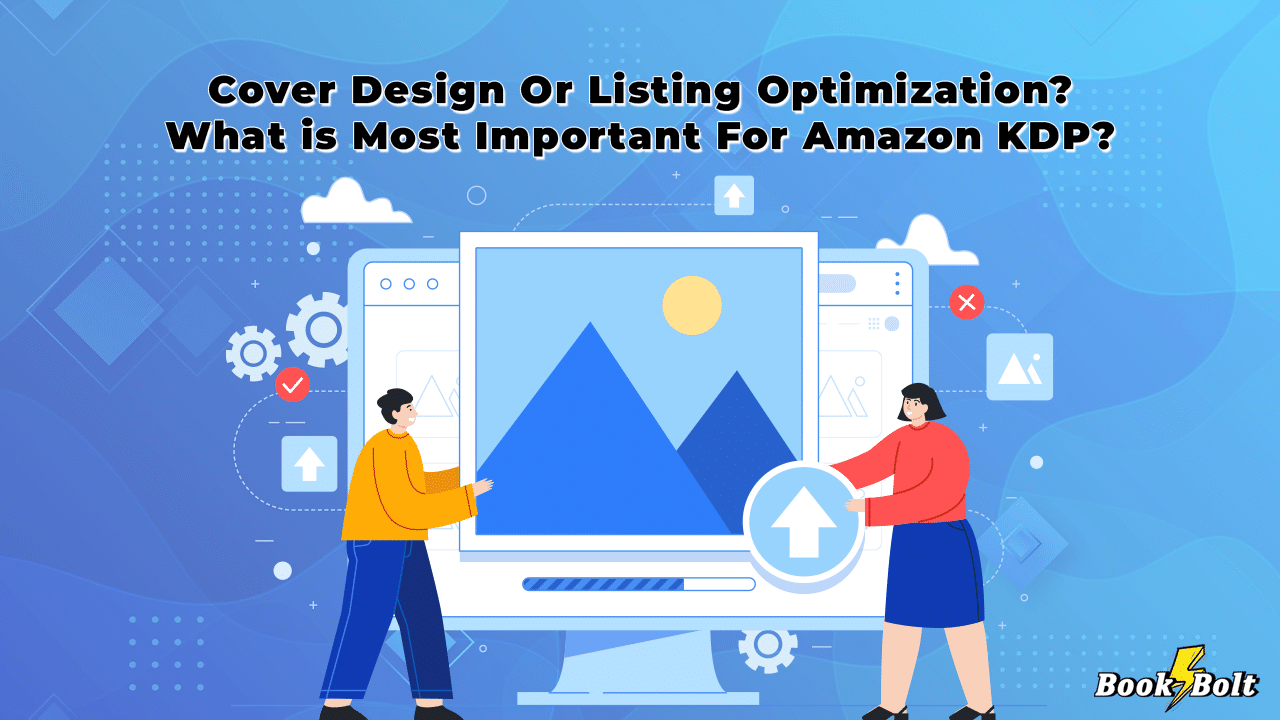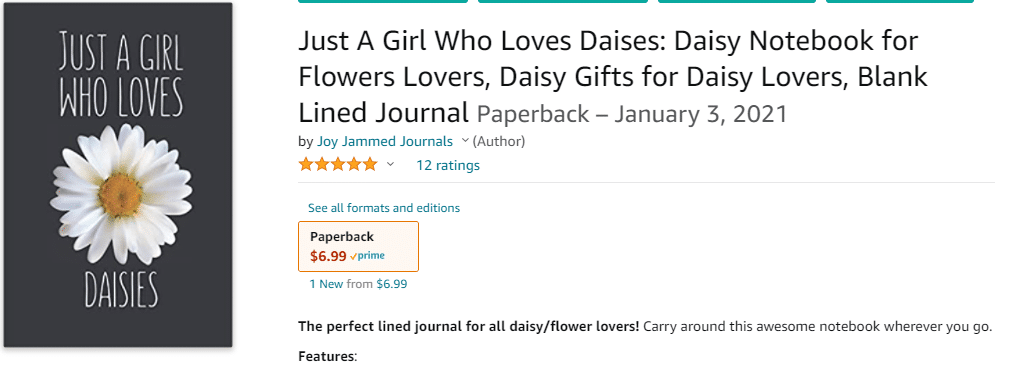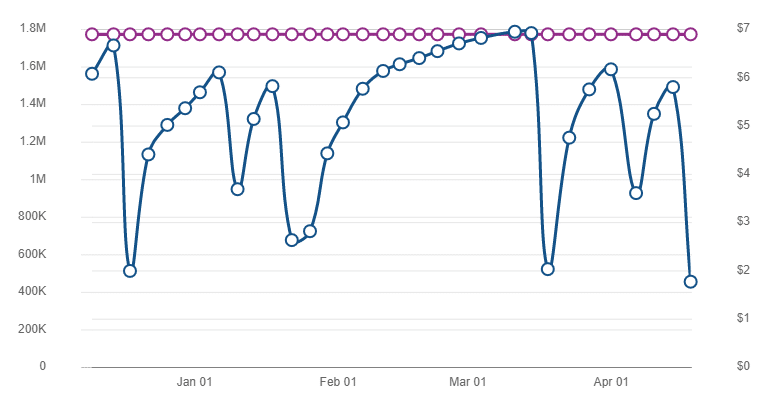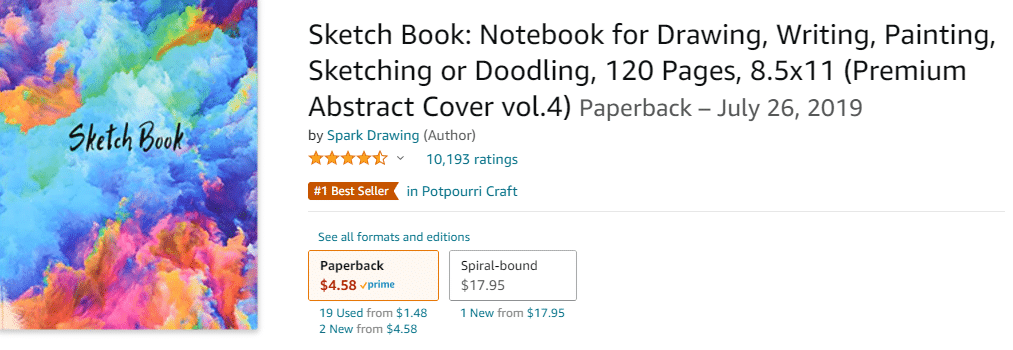
A successful Amazon KDP strategy means weaving together several factors in order to be profitable. For some, this might mean the importance of having a great cover design. Meanwhile, others might believe that listings optimization is the key to success.
This debate requires some careful consideration. After all: should you focus on your cover or your listings?
In this article, we try to resolve the dilemma by giving you a breakdown of both sides of the matter.
What Is The Importance Of Cover Design For KDP Success?
There are countless articles with tips and tricks on cover design online. They offer actionable ideas for colors, fonts, text, images and art, and are sure to help you make more sales.
One common theme that runs through them all is the importance of the cover in terms of selling no- and low-content books. Because let’s face it, no customer would want to buy a plain or boring cover. Instead, they’d rather go for a more striking and unique option that’s specifically targeted at them in the particular no- or low-content book niche.
It’s also argued that the visual is what catches the customer’s attention first. If the cover is attention-grabbing, then they will also consider the price. The visual, therefore, plays a critical role. And in the case of no- and low-content books, the visual is on the cover.
What Is The Importance Of Optimizing Listings For KDP Success?
If you’ve heard of search engine optimization, or SEO as it’s commonly referred to, you’ll know that search engines crawl sites to bring back the most relevant results to the user. The Amazon platform is no different. It acts very much like a search engine, and it even has its own algorithm.
Going back to the example of SEO, one of the key principles is figuring out what terms users are searching for so that the most valuable results can be provided to them. These terms are known as keywords. Answering a specific need while incorporating keywords into a text is one way of ranking higher on a search engine results page. While this is a very short and broad explanation of an entire professional field and industry, it generally boils down to optimizing a text so that it ranks higher.
Just like search engines, Amazon listings need to be optimized as well. Why? Well, the short answer is that if you don’t, you’re not likely to rank in the results page. This means that no matter how great your cover design is or how attractive your price, no customers will be willing to scroll through thousands of pages simply to find a needle in a haystack. Customers are looking for ease and convenience. They want the keywords they enter to give them the results they want. And they want it now.
Optimizing Your Listings On KDP
So, now that we’ve touched on the basics, let’s take a closer look at how listings can be optimized. There are two main legs to this approach.
Keywords: Keywords are the search terms that your customers use when looking for an item. Say I am an 18-year-old female who’d like to write notes and ideas and sketch in a daisy journal. I’d include the words “daisy” and “journal” in my Amazon search to give me the results I want. I’d scroll through the options available and pick the one I like the most. If its price is not suitable for my budget, I might keep looking around for other options. But generally, the keywords used by customers help a Seller determine their intent.
Knowing the customer’s intent, an optimization strategy can now be created and implemented. How? Well, it would involve incorporating (in a natural way, of course) relevant keywords in your title and description to give an accurate description of your book, its benefits, and who it’s best suited for. When the right keywords have been used, the chances of ranking higher on the Amazon search results page will also be much higher. This means more customers will get to see and be exposed to your book.
Pricing: We touched a bit on pricing a bit earlier and it’s time to look at this point in a bit more detail. Pricing can be a tricky thing to navigate. After all, when it comes to pricing, you’ll need to factor in how many pages your book will consist of, the amount of time and effort you put into creating the artwork for your cover, what your competitors are doing, etc. No- and low-content books that are not priced appropriately are not as likely to get sold. But what is an appropriate price, and should you really be searching manually through each competitor to see how they’re pricing their products? The answer to the latter is “no”.
A general rule of thumb in this business is that pricing your products too cheaply or underpricing them is not a good strategy. The reason for this is that an underpriced book is considered to be of low value or quality. Similarly, books that are priced too highly are going to be out of reach for many people and unless you’re specifically targeting a more affluent segment, then this strategy is not ideal either. The right way to approach this is to price around the average. And the best way to do that is to use Book Bolt to help you.
Which Strategy Carries More Weight In Terms Of Financial Gains And Long-Term Success?
Given all this, it might seem like we’re in a catch-22 situation. On the one hand, if you don’t have a great cover, the chances of someone buying the book are slim. On the other, even if you do have a great cover but haven’t optimized your listings, the chances of being found, seen, and purchased, are also very slim.
Let’s take a look at a practical example.
A buyer is interested in a sketchbook to doodle in. Typing this term into the Amazon search bar will immediately give you more than 10,000 results. It’s safe to say that no user is going to scroll through every single one of these 10,000 items to find the perfect book. It’s simply too much information to process and will waste a lot of time. This is why they’ll scroll down the first page (and then the second page if they really aren’t finding what they’re looking for) to see what the best-sellers are offering.
One of the top results for sketchbooks in the no- and low-content book category is “Sketch Book: Notebook for Drawing, Writing, Painting, Sketching or Doodling, 120 Pages, 8.5×11 (Premium Abstract Cover vol.4)” by “Spark Drawing”.
This Seller has accurately described their product in the title while also having a catchy, abstract cover that can appeal to a wide audience. They’ve priced this product at $4.58 and their rankings are at a whopping low best-sellers rank (BSR) of 965. They sell just over 600 of these products per month and they’ve gathered a large number of ratings. All this is looking pretty good.
Now, going back to the customer who looked for a sketchbook compared to the Seller’s strategy. This Seller has obviously optimized their listing by using the most appropriate keywords to get higher rankings and this has paid off. While the cover itself is appealing, if it weren’t for these rankings, it wouldn’t be as likely to have made a sale. Therefore, it’s possible to assume that your cover is what will get you to sell but in fact, it’s the listings optimization that does most of the work for you.
Book Bolt’s Advice For Sellers
With all this being said, it may be easy to conclude that listings optimization is what counts the most on Amazon KDP. However, this is not necessarily the case. In fact, the way that the process should be approached is by looking at it as two sides of the same coin. You’re lost without one or the other. But if you implement an effective strategy that includes both, you’re much more likely to see success with your no- and low-content book business.
As a final thought, we encourage you to use Book Bolt to help you maximize the potential of your cover design and optimize those listings. The platform offers Sellers absolutely everything they need in one spot, helping you find all the information needed with a single click of a button.
Try it! You’ll never go back.





Work Time
Your recommendations always help) Thanks for your work!